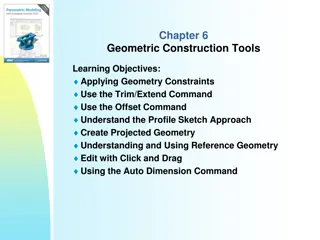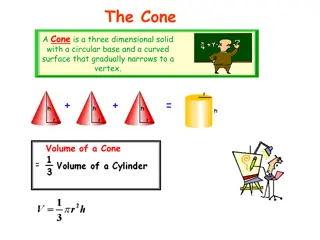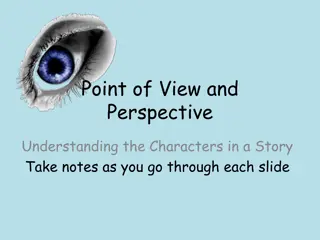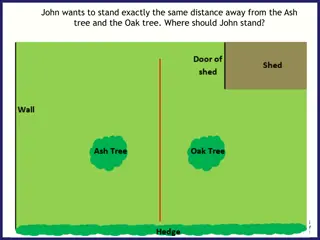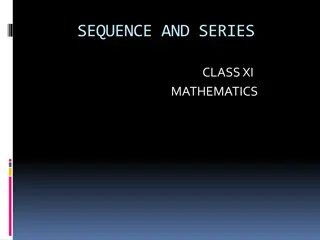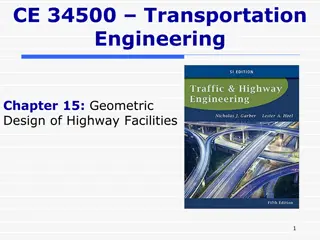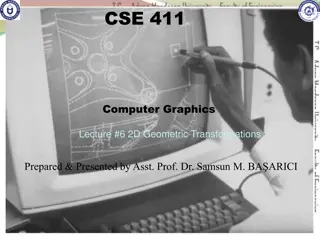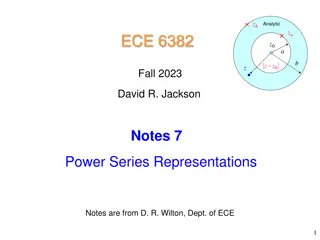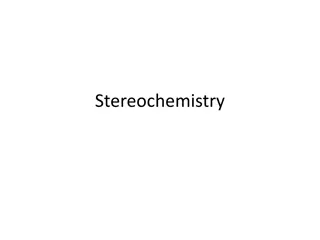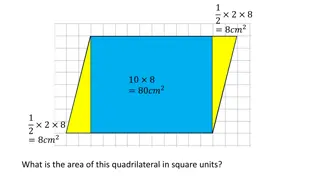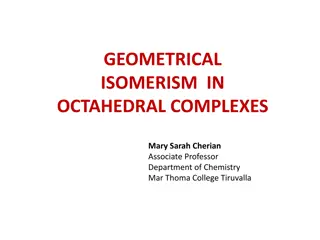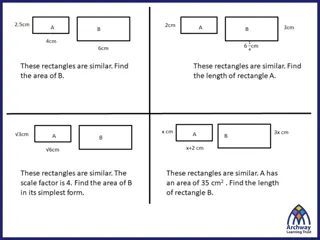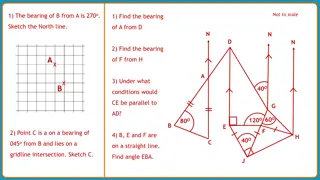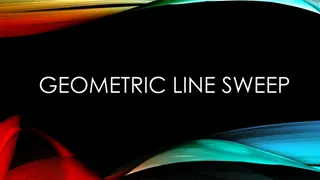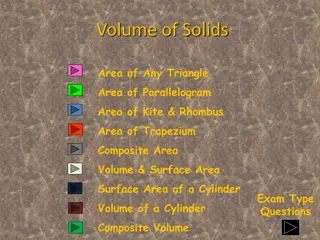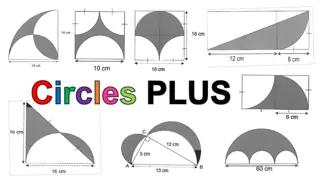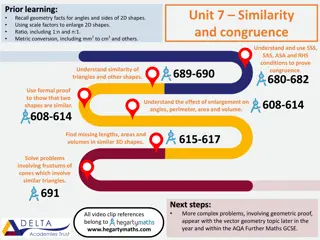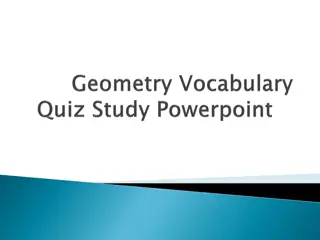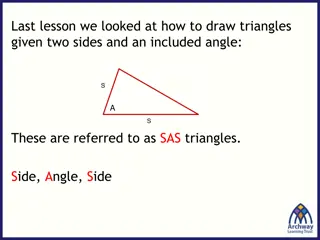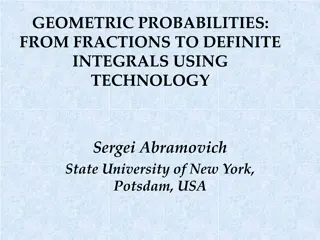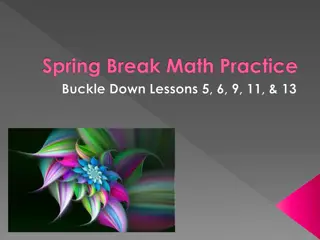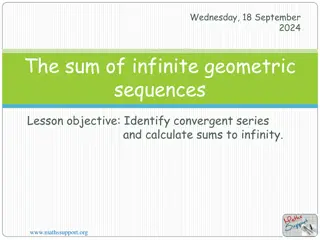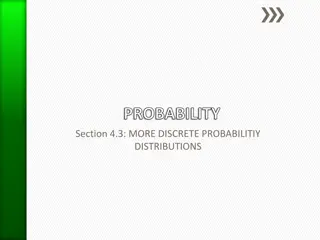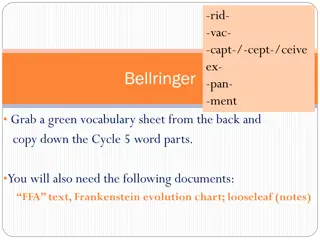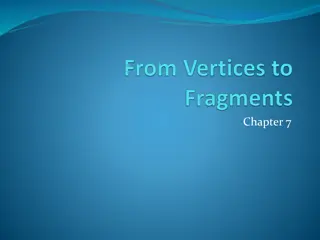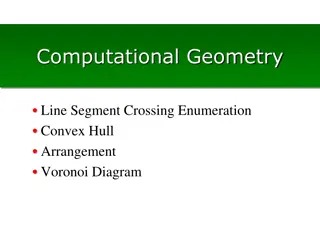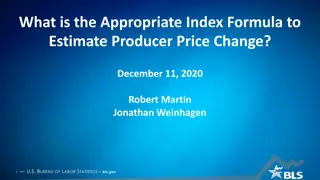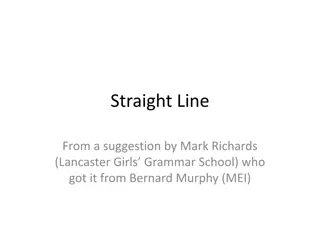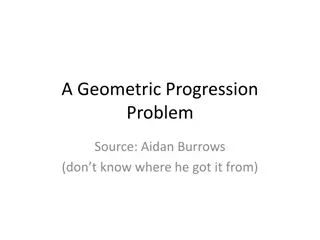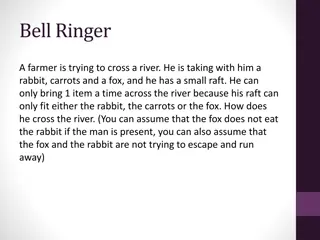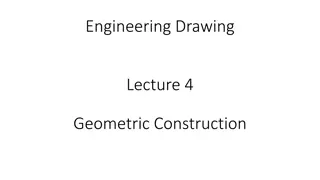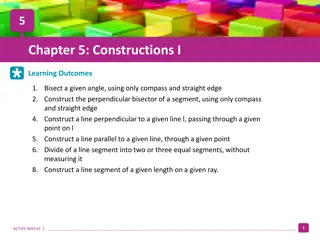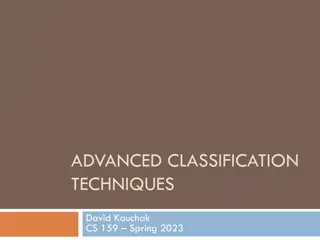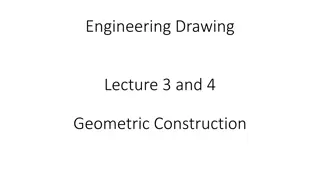Autodesk Inventor Geometric Construction Tools Overview
Explore the functionality of Autodesk Inventor's geometric construction tools, such as applying geometry constraints, utilizing trim/extend and offset commands, understanding profile sketches, creating projected geometry, and editing sketches with click and drag. Discover how to enhance efficiency i
3 views • 12 slides
Geometric Solids and Their Properties
Explore the concepts of cones and pyramids, including their volumes and surface areas. Learn how to calculate the volume of a cone or pyramid, find the surface area of their bases and lateral sides, and solve practice questions to enhance your understanding of these geometric figures.
1 views • 12 slides
Point of View and Perspective in Storytelling
Exploring the concepts of point of view and perspective in storytelling is crucial for understanding characters in a narrative. Point of view defines how the author presents the story to readers, while perspective delves into the lens through which the story is told, offering insights into character
1 views • 10 slides
Geometric Constructions and Perpendicular Bisectors
Explore geometric constructions involving equidistance, perpendicular bisectors, and circle drawing using compasses. Learn how to find the midpoint between two points, determine the path to stay equidistant from two objects, and construct perpendicular bisectors accurately. Enhance your understandin
2 views • 11 slides
Sequences and Series in Mathematics
Sequences and series are fundamental concepts in mathematics, with sequences consisting of terms denoted as a1, a2, a3, ... and series involving the sum of terms in arithmetic and geometric progressions. Learn about arithmetic progression, geometric progression, terms, and formulas for finding sums
2 views • 11 slides
Geometric Design of Highway Vertical Curves and Criteria
This content covers the vertical alignment in transportation engineering, focusing on the geometric design of highway facilities, specifically vertical curves like crest and sag curves. It explains the main design criteria for vertical curves, including minimum stopping sight distance provision, dra
2 views • 24 slides
2D Geometric Transformations for Computer Graphics
In this lecture on 2D Geometric Transformations, Assistant Professor Dr. Samsun M. BA ARICI covers topics such as translation, rotation, scaling, homogeneous representations, and coordinates. The lecture delves into basic transformations like reflection and shearing, as well as practical application
3 views • 81 slides
Geometric Series: Power Series Representations & Convergence
Geometric series analysis discusses the summation, convergence, and divergent properties within and outside the unit circle. The series' representation, convergence conditions, and extensions are explored through power series expansions and geometric series summations, providing a comprehensive unde
0 views • 50 slides
Stereochemistry: Isomers and Their Properties
Stereochemistry explores the fascinating world of isomers, including stereoisomers, geometric isomers, and structural isomers. Stereoisomers have the same molecular formula but differ in spatial arrangement, while geometric isomers lack free rotation around bonds. Structural isomers like dimethyl et
0 views • 27 slides
Geometric Problems and Solutions
Explore various geometric problems related to quadrilaterals, rectangles, parallelograms, and tangrams. Learn about finding areas, transforming shapes, and solving puzzles. Discover the principles behind turning a rectangle into a parallelogram and identifying areas of different geometric figures.
0 views • 7 slides
Using Smart View in PlanUW: Data Input and Reporting
Learn how to efficiently input data and build reports in PlanUW using Smart View. Discover the differences between data input forms and Ad Hoc grids, understand when to use each, and explore the steps involved in entering data via Ad Hoc. Find out how to open forms and reports in Smart View, as well
1 views • 6 slides
Geometrical Isomerism in Octahedral Complexes: A Comprehensive Overview
Geometrical isomerism in octahedral complexes is a fascinating phenomenon arising from different geometric arrangements of ligands. This type of isomerism is prevalent in coordination numbers 4 and 6, leading to two main types of geometric isomers. Examples of cis-trans and mer-fac isomers in MA2B4
5 views • 10 slides
Geometry Problem Solving and Volume Calculations
Solve challenging geometry problems involving spheres, cones, cylinders, and frustums. Calculate volumes, heights, and surface areas of various geometric shapes using proportional relationships and volume formulas. Explore concepts of mass, density, and similarity in geometric figures. Test your pro
0 views • 15 slides
Solving Bearings and Geometric Problems
This content discusses solving problems involving bearings, geometric shapes, and properties of triangles and lines. It covers determining bearings between points, finding angles in isosceles triangles, and understanding parallel lines and angles. The content also includes information on angles in q
0 views • 6 slides
Geometric Line Sweep Algorithms
Geometric Line Sweep is a powerful technique where an imaginary line sweeps over points, performing geometric operations at each point. This method can find minimum distances between points, overlapping rectangles, and more. By sorting points and efficiently processing them, it can enhance performan
0 views • 10 slides
Geometric Routing Concepts and Byzantine Fault Tolerance
Geometric Routing enables routing without overhead, where each node knows its global coordinates and forwards messages based on proximity to the destination. Byzantine Faults pose challenges with arbitrary node behavior, but a Byzantine-Robust Geometric Routing algorithm addresses this in a 3-connec
2 views • 33 slides
Examples of Advanced View Wireframes for Order Management System
This content showcases wireframe examples of an Advanced View for managing orders in a system. Each order has its own view with data connected in different tabs. The Details Slidein provides a summary of offers, orders, and customers, while the detailed view offers more in-depth information. The ima
0 views • 19 slides
Geometric Formulas for Area of Various Shapes
Explore formulas for finding the area of different geometric shapes such as triangles, parallelograms, rhombuses, kites, and more. Learn how to calculate areas efficiently and apply them to solve problems with units. Utilize diagrams and examples to grasp the concepts effectively.
0 views • 39 slides
Calculating Areas of Geometric Shapes
Explore the concept of finding the area of trapezoids, rhombuses, kites, and regular polygons using visual aids and explanations. Learn about the measurements needed, such as base, height, apothem, and more, to determine the area accurately. Practice calculating areas of various polygons like decago
0 views • 17 slides
Geometric Figure Calculations and Strategies
Various geometric figures composed of circles, rectangles, squares, triangles, and semicircles are analyzed to find the area, perimeter, and total area of shaded parts using different strategies. Formulas and step-by-step calculations are provided with the results rounded off to the nearest whole nu
0 views • 24 slides
Comprehensive Mathematics Prior Learning Overview
This comprehensive overview delves into key mathematical concepts, including geometry, equations, quadratics, and circle theorems. It covers topics such as similarity, congruence, vectors, and algebraic manipulation, preparing students for more complex problem-solving and geometric proofs. The conte
0 views • 6 slides
Geometric Shapes and Concepts Overview
Illustrations showcasing various geometric shapes and concepts including quadrilaterals with specific attributes, triangles with different angle measurements, endpoints and segments, and intersecting lines. Explore the visual representations to enhance your understanding of basic geometry.
0 views • 23 slides
Constructing SSS Triangles: A Geometric Exercise
Explore the construction of Side-Side-Side (SSS) triangles step-by-step, using compass and straightedge techniques to draw triangles given specific side lengths. Understand the process of constructing triangles without angle information and enhance your geometric skills with practical examples.
0 views • 13 slides
Geometric Probabilities: From Fractions to Integrals
Delve into the realm of geometric probabilities with insights on how to transition from fractions to definite integrals, utilizing technology for enhanced learning experiences. Understand the significance of probability calculations in quantifying likelihood, incorporating geometric representations
0 views • 26 slides
Math Practice: Ratios, Proportions, Estimation, and Geometric Figures
Explore math concepts such as ratios, proportions, estimation, rounding, and geometric figures through engaging lessons and problem-solving scenarios. Practice using proportions to find missing values, round whole numbers and decimals, estimate costs, and learn about geometric shapes. Enhance your m
0 views • 19 slides
Infinite Geometric Sequences and Convergent Series
Explore the concept of infinite geometric sequences in mathematics through the example of cutting a string into halves. Learn how to identify convergent series and calculate sums to infinity, distinguishing between convergent and divergent series based on the common ratio. Delve into the formula for
0 views • 12 slides
Geometric and Poisson Probability Distributions
Explore the geometric and Poisson probability distributions, including criteria for geometric random variables, formulas, and practical examples. Learn how to calculate probabilities using the geometric distribution and apply it in scenarios like Russian Roulette and blood donor collection. Dive int
0 views • 13 slides
Analyzing Character Development and Point of View in Literature
The content provides guidance on analyzing the development of characters in literary texts, evaluating authors' choices of point of view, and understanding how these elements influence readers' perceptions. It includes discussions on Victor's view of science in "Frankenstein," guiding questions for
0 views • 8 slides
Geometric Pipeline Implementation Strategies: From Vertices to Fragments
The chapter delves into the process of converting vertices into primitives, clipping out objects outside the view frustum, and determining affected pixels by each primitive. Tasks such as rasterization, transformations, hidden surface removal, and antialiasing are discussed. Various algorithms for c
0 views • 68 slides
Computational Geometry: Algorithms and Methods in Geometric Problem Solving
Explore the realm of computational geometry encompassing line segment crossing, convex hulls, Voronoi diagrams, and element distinctness reduction. Delve into techniques like line crossing checks, enumeration of cross points, and the sweep method, which are crucial for solving geometric problems eff
0 views • 32 slides
Overview of Proposed Changes in Producer Price Index Formulas
The U.S. Bureau of Labor Statistics is considering transitioning from a modified Laspeyres formula to a geometric Young formula for elementary indexes in the Producer Price Index (PPI). This proposed change aims to enhance the accuracy and economic relevance of price measurements by utilizing a geom
0 views • 25 slides
Solving Geometric Problems with Straight Lines
Explore a unique geometric problem involving straight lines and triangles. Follow the step-by-step process to find the areas of red and blue triangles, determine the numerical area of the intersection, and derive the equation of the line using coordinate geometry. Illustrative images aid in understa
0 views • 21 slides
Solving a Geometric Progression Problem with Given Differences
The problem involves determining the two possible values of the first term and the associated common ratio in a geometric progression, given the differences between terms. By following the steps outlined in the solution, the first term is calculated to be 1.2 or 3.2, and the common ratio is determin
0 views • 28 slides
Geometric Solids Volume Formulas Explained
Understanding the volume of geometric solids is crucial for various practical applications. Learn about different shapes like rectangular prisms, cylinders, cones, and spheres, along with their respective volume formulas. Dive into the concepts of diameter, radius, and height to master calculations
0 views • 13 slides
Geometric Construction and Geometrical Figures Lecture Images
Explore a series of informative images illustrating geometric construction, types of angles, triangles, and various geometric figures like squares, rectangles, rhombuses, parallelograms, and circles. Enhance your understanding of key geometric concepts with these detailed visuals.
0 views • 14 slides
Geometric Constructions: Mastering Compass and Straight Edge Techniques
Explore the art of geometric constructions using only a compass and straight edge. Learn to bisect angles, construct perpendicular bisectors, draw lines perpendicular to given lines, create parallel lines, divide line segments equally, and more. Equip yourself with the necessary skills and technique
0 views • 11 slides
Geometric Approach to Classification Techniques in Machine Learning
Explore the application of geometric view in advanced classification techniques as taught by David Kauchak in CS 159. Understand how data can be visualized, features turned into numerical values, and examples represented in a feature space. Dive into classification algorithms and discover how to cla
0 views • 65 slides
Theories of Reading Processes in Language Learning
Explore different theories of reading processes in language learning, including the traditional view, bottom-up view, cognitive view, and metacognitive view. Discover how readers acquire skills, the importance of linguistic features, and the role of readers in understanding texts. Dive into intensiv
1 views • 21 slides
Geometric Frustration in Magnetism and Ice
Explore the concept of geometric frustration in magnetism and ice, where energetic requirements cannot be optimized simultaneously. Learn about frustrated magnetic insulators, quantum spin liquids, and the unique properties of geometrically frustrated systems such as triangular and Kagome lattices.
0 views • 25 slides
Geometric Construction in Engineering Drawing: Lecture Highlights
Geometric construction involves creating primitive geometric forms like points, lines, and planes to define objects in space. The lecture covers the basics of 2D geometric primitives, such as points, lines, circles, and arcs. It explains the significance of points and lines in technical drawings and
0 views • 18 slides
